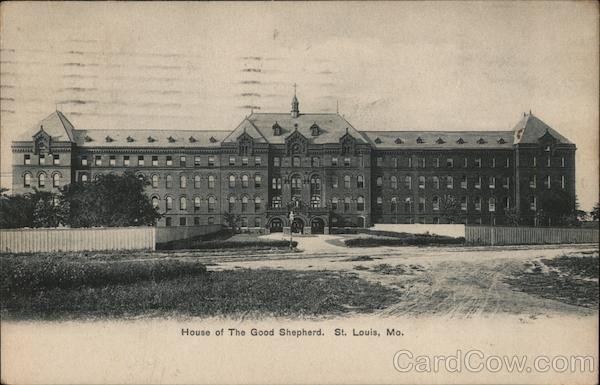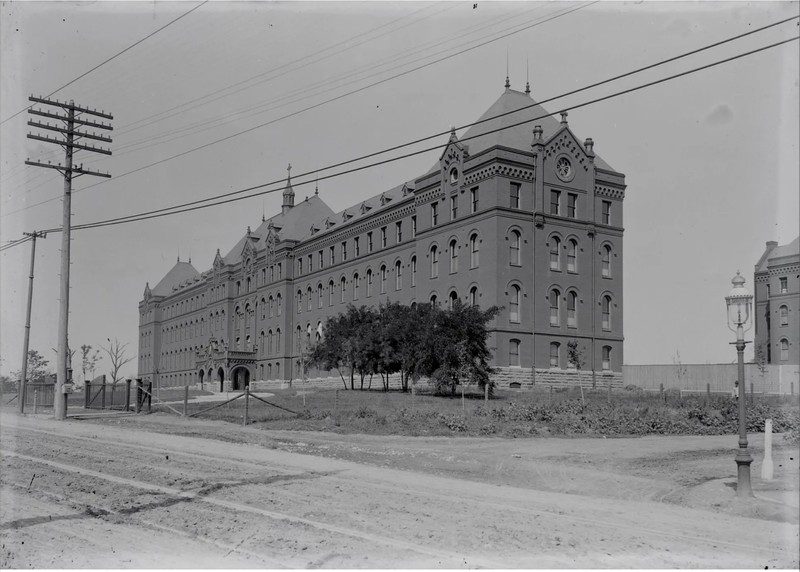House of the Good Shepherd of St Louis (Circa 1840-1969)
Introduction
Text-to-speech Audio
Created in the 1840s, the House of the Good Shepherd of St. Louis provided housing for unwed mothers and girls that were said to have impoverished or 'morally questionable' parents. In 1895, the organization moved to a building here on the Northwest Corner of Gravois and Bamberger.
Images
House of the Good Shepherd of St. Louis, circa 1909

House of the Good Shepherd, Northwest Corner of Gravois and Bamberger

Backstory and Context
Text-to-speech Audio
The House of the Good Shepherd of St. Louis operated in the St. Louis area as early as the 1840s and moved to this location in 1895. The home operated here until 1969 when the organization closed its doors. During its years of operation, many of the girls and women who lived here were sent to the House by the city courts or by order of the City Health Department. Others choose to individually seek the help of the Sisters of the Good Shepherd.
There were five categories of women who operated the House of the Good Shepherd of St. Louis: The Sisters of the Good Shepherd, the Magdalens, those who served children, the workers in the reformatory, and those who operated the clinic. The Sisters of the Good Shepherd were responsible for overseeing day-to-day operations in the building, and also for guiding the rehabilitation of the women known as the Magdalens. The “Magdalenes were "reformed prostitutes" who were permitted to live in the back building for as long as they desired according to an article by Chris Naffziger.
According to researcher Nancymarie Phillips, “The Sisters Magdalen practiced perpetual silence rising at 4 AM and retiring at 9 PM. One hour of recreation followed each of their two meals during which they could speak. In 1964 they were known as the Sisters of the Cross to shed the erroneous association with Mary Magdalen as a “fallen woman.”
The lot where the House of the Good Shepherd of St. Louis once stood is now home to a fast food establishment, but photographs and historical records show that the original facility was quite extensive. Several ornate gates guarded the entrance to the property. The convent and grounds included a chapel, a school with a library and principal's office, a gymnasium, dormitories, a power plant, a laundry area, a swimming pool, and courtyards. According to the 1930 St. Louis census, many of the inmates were from Missouri and Illinois. There were a few international inmates from places such as Canada, Switzerland, Ireland, Germany, Scotland, and England. The oldest resident at the time was ninety-four years old, while the youngest was merely six years old. At this time, a majority of the residents were single, but there were a few women who were married, widowed, or divorced.
The building itself closed in 1969 when the Sisters of the Good Shepherd relocated from downtown St. Louis to Florissant, Missouri. The property at 3801 Gravois Ave needed extensive repairs, which led to the decision of the organization to sell the property and downsize to a smaller facility. At the time of the move, about one hundred and twenty nuns and girls resided at the convent under the leadership of Sister Mary Gertrude Scanlan. Twenty-nine sisters and about forty-five girls ranging in age from thirteen to seventeen were relocated to the new facilities on Mullanphy Road in Florissant, called Marygrove. The House of the Good Shepherd organization still operates in the St. Louis area. The archives for the Sisters of the Good Shepherd Province of Mid-North America were located in St. Louis, although it appears that some of the records have been distributed to other branches of the organization.
Sources
"Archival Request – Sisters of the Good Shepherd." Sisters of the Good Shepherd. https://sistersofthegoodshepherd.com/archives-2/
"Former Judge Mix Praises Convent of Good Shepherd." The St. Louis Star December 3rd, 1930., 8.
Brophy, John R. "Convent of Good Shepherd closes in St Louis, Missouri, moves to Florissant." St. Louis Post-Dispatch, July 11th, 1969.
Corbett, Katharine T. In Her Place: A Guide to St. Louis Women's History. St. Louis, Missouri. Missouri History Museum, 1999.
Naffziger, Chris. The old Shop 'n Save strip mall on Gravois in Tower Grove South used to be an idyllic picnic ground called Bamberger’s Grove. What happened?, St. Louis Magazine, September 3rd, 2020. https://www.stlmag.com/history/bamberger-avenue-grove-picnic-ground/.
Phillips, Nancymarie, "Education for Girls in the House of the Good Shepherd, U.S. 1940-1980" (2008). ETD Archive. 241. https://engagedscholarship.csuohio.edu/etdarchive/241
Lossos, David A. and Becker, Shirley. 1930 St. Louis Census - House of Good Shepherd Volunteer Transcriptions Project, Genealogy in St. Louis. May 29th, 2002. https://stlouis.genealogyvillage.com/1930hgs.htm.
The St. Louis News Company. Image courtesy of CardCow.com
Photograph by Richard Henry Fuhrmann, Missouri History Museum, P0764-00196-5g
